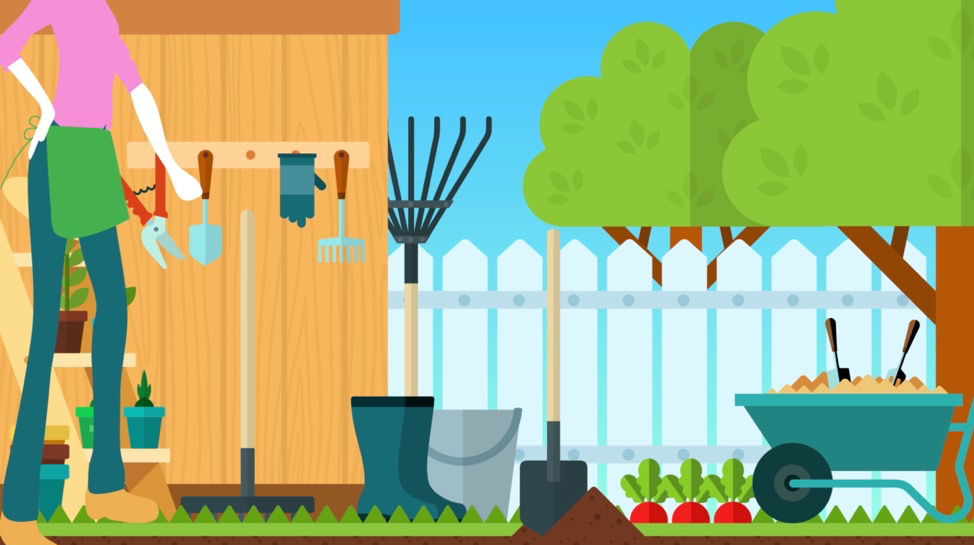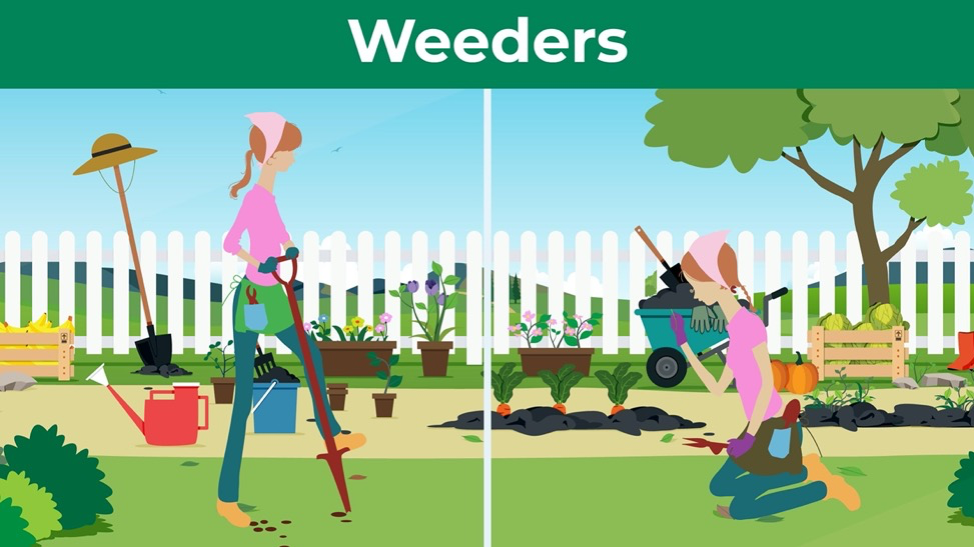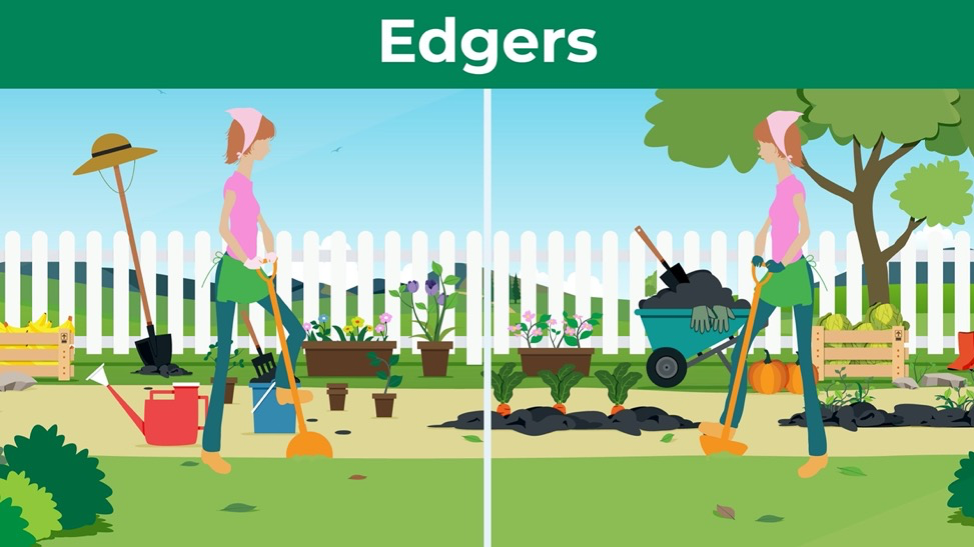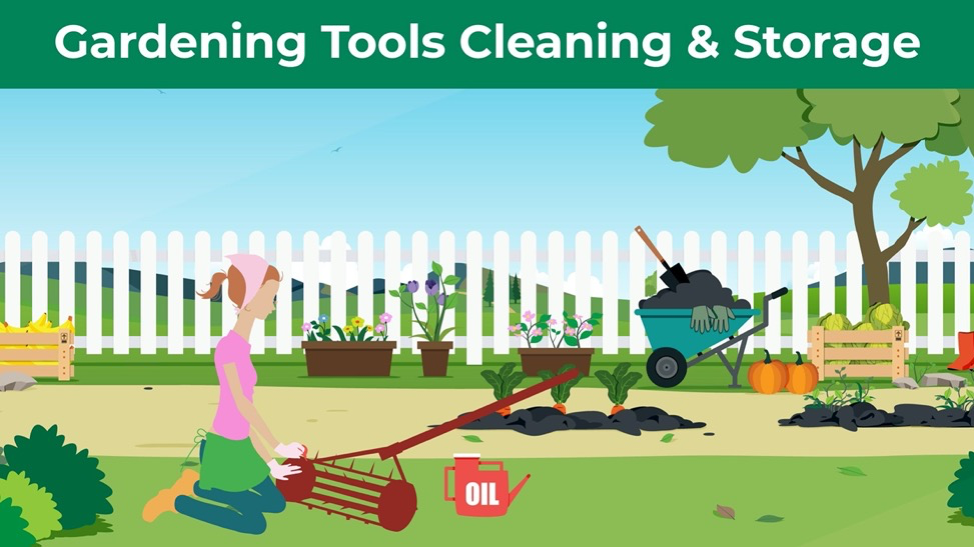You can name a few gardening tools off the top of your head—but do you know all the ways you’re able to use them? What about the tools you don’t even know a name for? From digging devices to nifty knives, make sure you know how to leverage different equipment in your garden, as well as how to keep it clean and safely stored away.
Guide to 15 Garden Tools and How They Can Work for You
Garden Hoe
Let’s begin with a classic: the age-old garden hoe. It’s the quickest method for setting pits just below the surface of the soil, into which you’ll later sprinkle seeds. Especially if you’re plotting out a vegetable garden, this tool is a must-have for establishing and spacing your rows. It’s also ideal for tasks like harvesting vegetables, shaping soil, spreading compost in tight spaces, and clearing old crops and weeds. While you can choose a short-handled or long-handled hoe, a longer handle will prevent back strain from bending and kneeling. Working with spacious areas such as vegetable gardens might require a wider blade, whereas for flower gardens, a delicate blade might be best.
Hand Trowel
Think of it as your handheld mini-shovel. Hand trowels are perfect for digging, transplanting, refilling, weeding, and even edging. You can relocate small plants, transfer dirt into pots, and plant bulbs or seedlings. Whether you’re an urban gardener with a family of container plants on your porch or nursing a full plot in the backyard, this tool is an essential. Pro tip: Due to their size, hand trowels can become easily misplaced while working out in the garden, so one with a bright-colored handle could prove handy.
Weeder
Pulling weeds may very well be a gardener’s most-dreaded task. Handheld weeders with a forked end are a less frustrating way to loosen the soil and grab hard-to-reach weeds. You might not be able to avoid pulling them one at a time, but you’ll at least spare your hands some labor (and the undersides of your fingernails some dirt). A traditional hand weeder should do the trick, though some gardeners prefer standup weeders with a foot lever that pushes spikes into the ground and uproots the weeds.
Pruning Shears
For maintaining trees, shrubs, and other blooms with unruly branches and sprouts, a pair of sharp pruning shears is a must. They make a clean cut through small branches and thick stems or vines, no matter if you’re harvesting vegetables in the summer or cleaning up the trees before winter.
Garden Scissors
As opposed to hand pruners—which are best fit for large-flowered plants—garden scissors are used to trim smaller and delicate flowering plants, as they provide more control and precision. Knowing the how and why of pruning and deadheading techniques is invaluable to gardening success.
Garden Rake
Although you should definitely have a classic leaf rake on hand, that’s not going to do the trick for cultivating your soil. Opt for a sturdier bow rake with steel tines, which will more effectively spread mulch, clear leaves, and level out and comb through the soil’s surface. Individual raised beds and expansive community gardens alike can benefit from this tool.
Digging/Spading Fork
Garden rakes will break up the soil just fine, but spading forks are your go-to for turning dirt and penetrating past the surface. This four-pronged, pitchfork-like tool has sturdy tines for loosening hardened soil and mixing materials like compost or mulch.
Curved-Blade Shovel
Unless you’ve got your own personal excavator sitting around your yard ready to unearth the landscape, an old, trusty, full-length digging shovel is essential. It’s your most heavy-duty tool for breaking and leveling the ground, as well as preparing to plant trees, shrubs, and other larger plants. Curved-blade shovels are also good for relocating smaller loads of dirt from a wheelbarrow into the garden. You may use them to stir potting soil or compost piles, too. And of course, these shovels have a place for footing so you can firmly stomp it down (and step up your garden game).
Flat Spade
Whereas curved-blade shovels are designed for scooping, flat shovels (or spades) are designed to dig—but with more precision. When it comes to edging work or bordering a new garden plot, that calls for the functionality of a flat, full-length, straight-edge shovel to help section out the garden of your dreams. Use these spades to remove a plant from the soil and dig its new hole and to help avoid disturbing established plants when working around tight spaces.
Garden Knife (Hori-Hori)
Even seasoned gardeners might not be equipped with this one. The hori-hori claims origins in Japan, and the word is the onomatopoeia equivalent for a digging sound. That said, the garden knife is easily one of the most versatile tools, no matter how you plan to toil in the soil. Use it to mark the dirt, cut through roots, or divide plants. With a curved shape, serrated (jagged) blades on both edges, a sharp point, and inch markings for quick reference during planting, this device will get the job done. You could say that we dig it.
Dibber
The pointed, carrot-shaped dibber is a great sidekick in forming planting holes for seedlings or bulbs. There are several variations of the tool, including a straight, trowel, L-shaped, and T-handled dibber. Some feature calibrated rings indicating depth for the most accurate planting.
Edger
Edgers are used to—you guessed it—establish edges and borders in your soil by forming tidy, defined lines within garden beds or between the grass and walkways. With manual edgers, the bottom of the blade forms a semicircle and, like a shovel, the top features a lip for pressing down with your foot. After penetrating the soil, rock the tool back and forth, and repeat while moving down the line. If you have a lot of ground to cover, power edgers can be pulled across the landscape as it does the digging for you. Or, if you’re looking to set up a simple border around your garden, our Emerald Edge is a practical choice.
Rolling Lawn Aerator
If you’re striving to achieve a luscious lawn, there’s a lot of work required, but rolling lawn aerators can take on a little of the labor. Somewhat resembling an old-fashioned lawnmower, lawn rollers are pushed across the grass to help level the soil and settle newly sown seeds, quickening the germination process. They penetrate the soil to promote air, water, and nutrient flow to the roots. If lawn pests like moles can’t seem to get enough of playing your yard, lawn aerators can smooth out these bumps and blemishes. However, use this tool sparingly, as it can induce stress to your grass. When you do perform a roll-over, the dirt should be moist but not wet; soaked soil increases compaction, thus decreasing aeration (and the health of your lawn).
Types of rolling lawn aerators include manual rollers that you push yourself as well as large rollers you can pull with a utility vehicle. If one of these tools isn’t a frequent need or in your budget, check if your local hardware store offers the option to rent them out.
Stool and Knee Pads
It’s not your typical gardening device, but you can’t spell “stool” without “tool.” Take it easy on your back and knees with a padded garden kneeler/seat hybrid. Even well-oiled joints will squeak out in relief! If a collapsible stool isn’t your style, you can always opt for a pair of knee pads.
Expandable Garden Hose with Adjustable Spray Nozzle
A standard hose does the trick for some outdoor gardens, but if you use it on lots of different plants, a lightweight, expandable garden hose will prove easier to snake around the yard. Additionally, adjustable spray nozzles can be a lifesaver when it comes to more delicate or sensitive plants. Not only will you waste less water with control over the spray settings, but you’ll also be able to choose between misting and soaking your plants—or anything in between. After all, don’t you enjoy the luxury of adjustable showerheads? Your plants do, too.
Cleaning and Storing Your Garden Tools for Winter
Depending on how brutal your winters are, each year, there’s likely a point at which you allow your garden—and garden tools—to hibernate. It’s wise to clean up your equipment before storing it away to prevent damage or further rust and to ensure it’s ready to go for next season.
Here are some sanitation and storage tips to keep in mind:
- Consider taking your tools apart to clean hard-to-reach spots.
- Rinse dirt off tools with a water hose, then dry with a cotton cloth.
- Thoroughly clean any tools with tines inside and out with water and a cloth or brush.
- For stubborn dirt and rust, scrub with steel wool, a bristle brush, or a thick cotton cloth.
- Use a file or stone to sharpen the blades of tools.
- Apply a light coat of oil to prevent rust.
- Motor oil, WD-40, or even vegetable oil are effective rust preventers because it insulates steel, preventing it from oxidizing.
- Oil can be applied to metal surfaces either by spraying or wiping it on with a rag.
- Hang tools by their handles on a wall in your shed or garage; this will keep them organized, out of the way, and protected from damage.
- For fuel-powered tools:
- Lubricate all lubrication fittings.
- Disconnect all batteries and spark plugs.
- Clean or replace any air filters.
- If storage will exceed 30 days, empty any tanks containing pump gasoline, as it deteriorates quickly.
- For edgers, trimmers, chainsaws, and tools with similar engines, empty the tank and run at an idle until all the fuel is used up.
- For lawnmowers, it’s generally recommended to add a fuel stabilizer to the tank instead of draining it. Run the engine to mix the stabilizer into the system, then fill the tank with fresh fuel; this prevents the accumulation of damaging water condensation during storage.
Expanding Your Gardening Toolbox with Jobe’s
At Jobe’s, we want to add to your toolbox by meeting you where you’re at in your gardening experience. Proper outdoor equipment is the first step to breaking ground on projects and paving the way to new possibilities. Whether you need a compost starter to enhance your soil quality or garden edging to divide up your plot, Jobe’s offers a comprehensive selection of trusted products to support your goals.



